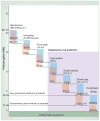Biofuels from algae: challenges and potential
- PMID: 21833344
- PMCID: PMC3152439
- DOI: 10.4155/bfs.10.44
Biofuels from algae: challenges and potential
Abstract
Algae biofuels may provide a viable alternative to fossil fuels; however, this technology must overcome a number of hurdles before it can compete in the fuel market and be broadly deployed. These challenges include strain identification and improvement, both in terms of oil productivity and crop protection, nutrient and resource allocation and use, and the production of co-products to improve the economics of the entire system. Although there is much excitement about the potential of algae biofuels, much work is still required in the field. In this article, we attempt to elucidate the major challenges to economic algal biofuels at scale, and improve the focus of the scientific community to address these challenges and move algal biofuels from promise to reality.
Figures





References
-
- Parry ML, Intergovernmental Panel on Climate Change, Working Group II, World Meteorological Organization, United Nations Environment Programme . Summary for Policymakers. In: Parry ML, Canziani OF, Palutikof JP, van der Linden PJ, Hanson CE, editors. Climate Change 2007: Impacts, Adaptation and Vulnerability Contribution of Working Group II to the Fourth Assessment Report of the Intergovernmental Panel on Climate Change. Cambridge University Press; Cambridge, UK: 2007.
-
- Dyni JR. Scientific Investigations Report 2005-5294. US Geological Survey; VA, USA: 2006. Geology and resources of some world oil-shale deposits.
-
- Schindler J, Zittel W. Crude Oil – The Supply Outlook. Vol. 102. Energy Watch Group; Ottobrunn, Germany: 2008.
-
- Energy Information Administration. International Energy Outlook. Vol. 284. EIA; DC, USA: 2009.
-
- Nass LL, Pereira PAA, Ellis D. Biofuels in Brazil: an overview. Crop Sci. 2007;47:2228–2237.
Grants and funding
LinkOut - more resources
Full Text Sources
Other Literature Sources
